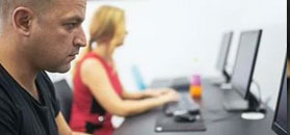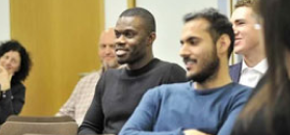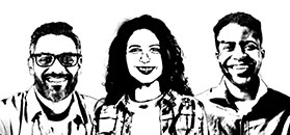As a mountain rescue volunteer, Matthew Greaves believed there had to be a better solution than sending out a helicopter every time a walker or climber got lost in the hills. Such a simple thought was to change not only his volunteer work, but his entire career in IT.
Tell me about the founding of Drones on Demand?
I’m a volunteer mountain rescuer. Six or seven years ago, I was on the search for a chap that had gone missing. We had support from the police air unit, but then they got retasked onto something else. It made me think, ‘wouldn’t it be great if we had our own police helicopter that we could send wherever we wanted it, that wasn’t going to get retasked onto other things?’ That got me thinking about drones.
Back then, it would cost around £80,000 to get something that would get you a thermal camera in the air and even then, it would only be able to stay in the air for about ten minutes. So, not really suitable for our use, but it got me thinking, ‘mountain rescue can’t afford to do it, but if I was selling it as a service to somebody else, I could also offer it to mountain rescue.’
Prior to founding Drones on Demand, my background was very much in IT. I began my career on the Halifax graduate scheme, then worked as an analyst, project manager and program manager across a range of organisations; including the Department of Work and Pensions, Boots, Co-op and JD Williams. In most of my roles, I was delivering transformational IT change.
Tell me more about drone uses?
Five years ago, drones were used pretty much solely for doing videos for TV and films. You can’t watch anything on telly now without there being some sort of drone footage in it - but that’s not what I’m interested in. My main interest is not so much in the drone itself, but as a tool to collect data and what you can do with that data.
We mainly use our equipment for conducting inspections or survey work. We can get a camera or some other type of sensor somewhere it’s either difficult, dangerous, or sometimes expensive to send a person.
I’ve recently worked for the insurer, Ecclesiastical, using drones to access areas on buildings such as stately homes, schools and churches. For one of their clients, Worcester Cathedral, we completed a detailed survey, scanning every single centimetre and providing really detailed photography. This enabled them to complete an initial condition assessment and prioritise future work and inspections.
The staff at the Cathedral were aware that parts of the tower needed to be inspected, but the costs and logistical challenges of doing this, meant they had not been able to do so.
Tell me about the process?
Most inspections are a case of taking some kind of photography, then providing this to our clients. Often, for complex buildings, we will also provide a map showing where each photo was taken, so that the photo location can be easily located on the building and an engineer tasked to the location if necessary.
For surveying areas, we usually use photogrammetry - this is the science of creating 2D maps and 3D models from photographs. We will take lots of overlapping photographs that, when coupled with the GPS data from the drone, can be processed to create two-dimensional and three-dimensional representations of what was there.
If you can imagine the satellite view from Google Maps, that is photogrammetry, but done using data from satellites. What we do is very similar to that, but at the point at which you can’t zoom in on Google Maps anymore; you can probably zoom in four or five clicks more. The resolution of the data that we process all depends on the intended usage, but it can be anywhere from five, down to less than one centimetre per pixel. Therefore, a centimetre on the ground is a pixel on the screen.
Before using drones to survey an area, you would typically have used a total station or a GNSS receiver. A surveyor would walk the site taking measurements every five or 10 metres and then would produce a grid of the points that they had surveyed - this would usually be quite basic in today’s terms. Using the drone, we can produce data that, instead of one point every 10 meters, has hundreds of points per square metre.
What about the accuracy of the GPS?
The GPS equipment that’s on most of the off-the-shelf drones is not accurate enough to produce data for surveying. It will be able to produce something that looks good, but isn’t accurate enough to produce survey-grade deliverables.
To produce accurate data, we’ll use a drone that has advanced GPS receivers on it, which can also be corrected by readings from other GPS receivers - either in real time (RTK) via a network connection, or post processed (PPK) in the office after the flight.
While standard GPS is accurate to a few metres, RTK and PPK is accurate to between 20mm and 50mm. This produces survey-grade data that can be used to take measurements.
How do you manage data collection and how do you store it?
If we’re surveying a large site, it could well generate around 80GB worth of data. There’s a couple of issues with that. First of all, storing it isn’t too much of a problem (storage is relatively cheap), but when you start looking at moving that volume of data onto corporate networks - that’s when clients start to panic! Having looked at many different solutions, the quickest way to move and provide instant access to the data is to put it onto a hard drive and post it.
So, a very 1990s solution to a 21st century problem?
It is, and the main challenges are with the speed of broadband and corporate networks. Moving large datasets between datacentres connected with a fibre backbone is one thing, but standard ADSL, fibre broadband and standard corporate networking equipment leads to issues with timeouts, latency and hitting bottlenecks where network components have been throttled. This causes big issues where we are trying to move single large files (1Gb+) or hundreds of small files (4Mb). The fact is, corporate networks just aren’t geared up for moving that kind of volume of data.
Generally, it’s easier for these smaller clients to receive, move and manipulate the data than the larger organisations, as they are able to use tools like file sharing websites and are able to access the high-specification computers required to make best use of the data.
How have drones changed in the last few years?
The actual method of flight hasn’t moved on all that much over the last five years. What has changed massively, is that the cameras and sensors have got smaller and lighter and battery technology has advanced, meaning that the energy is packed more densely.
The advances mean the drones themselves have got smaller and lighter and are able to stay airborne for longer. The first drones I was flying were maybe 10 or 11kg and would stay in the air for about 12 minutes, carrying a high-resolution camera at a cost of around £20,000. Today, you can get a similar specification camera in the air for about 4kg for 40 minutes at a cost of around £6,000.
There have also been big steps forward in the software that is in the drone - as in the software that controls the drone from the ground. Most drones are now integrated into a fairly significant application eco-system that allows them to integrate with iOS, Android and Windows devices.
What’s the next big thing in drones?
The thing that really interests me are the different sensors that are now starting to become available to fit onto drones. The sensors are getting smaller and lighter and that means we can start thinking about how we can attach them onto drones and start to fly them to capture data that was maybe impossible to capture previously.
One of the (almost) mainstream sensors that has been miniaturised and is now coming to market is LiDAR. As an alternative to using photogrammetry, LiDAR sends out laser beams thousands of times a second and records the data when it bounces back to produce a 3D point. Millions of measurements are taken, which produces a point cloud. Each point has a real-world X, Y and Z co-ordinate, which means that the data can be used to build a 3D model.
It is still quite a fledgling industry (no pun intended), with the technology rapidly moving forwards. New applications for the technology and data are being identified almost weekly and with the miniaturisation of sensor payloads, it’s really exciting to see where the technology will be headed next.
Is there anything that drones don’t do now that you think they will?
I think Drone 2.0 will probably be when drones start to interact with their environment. At the minute, nearly everything that drones are being used for is ‘just’ to collect data. The next natural progression I think will be when drones start to do things, such as making repairs to inaccessible areas.
The University of Leeds is currently researching marsupial drones - that’s when the payload of the drone is another, different type of drone. The scenario that they have tested uses a large drone to place a small-wheeled magnetic drone onto a steel structure which then moves around the bridge taking measurements of the steel thickness on the bridge. In the case of the capability of drones, I think we’ve barely scratched the surface of usage possibilities.

















